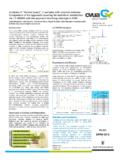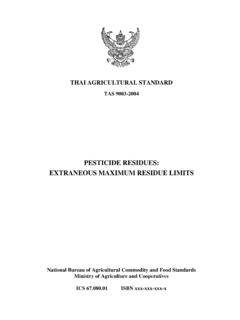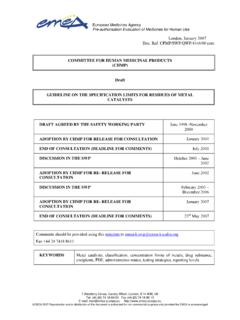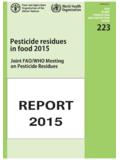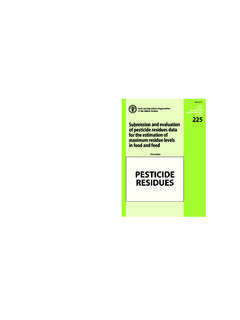Transcription of JOINT FAO/WHO MEETING ON PESTICIDE RESIDUES
1 Summary Report from the May 2016 JOINT FAO/WHO MEETING on PESTICIDE RESIDUES (JMPR) JOINT FAO/WHO MEETING ON PESTICIDE RESIDUES Geneva, 9 13 May 2016 SUMMARY REPORT Issued 16 May 2016 Edited versions of these evaluations and general considerations will be published in the report of the May 2016 JMPR. They are reproduced here so that the information can be disseminated quickly. These drafts are subject to technical editing. A JOINT MEETING of the Food and Agriculture Organization of the United Nations (FAO) Panel of Experts on PESTICIDE RESIDUES in Food and the Environment and the World Health Organization (WHO) Core Assessment Group on PESTICIDE RESIDUES (JMPR) was held at WHO Headquarters, Geneva (Switzerland), from 9 to 13 May 2016. Diazinon, glyphosate and malathion were placed on the agenda by the JMPR Secretariat, based on the recommendation of the last session of JMPR to re-evaluate these compounds given the number of new studies that had become available since their last full assessments.
2 The following extracts of the results of the JOINT FAO/WHO MEETING on PESTICIDE RESIDUES (JMPR) are provided to make them accessible to interested parties at an early date. More information on the work of the JOINT FAO/WHO MEETING on PESTICIDE RESIDUES (JMPR) is available at: Summary Report from the May 2016 JOINT FAO/WHO MEETING on PESTICIDE RESIDUES (JMPR) 1. Evaluation of data for acceptable daily intake (ADI) and acute reference dose (ARfD) for humans Diazinon (22) Diazinon is an insecticide with a wide range of insecticidal activity. Several epidemiological studies on cancer outcomes following occupational exposure to diazinon were available. The review of these studies provided no convincing evidence of a positive association between exposure to diazinon and non-Hodgkin lymphoma (NHL), but there was weak evidence of a positive association between leukaemia and exposure to diazinon and between lung cancer and exposure to diazinon from one large cohort study only.
3 In studies submitted, diazinon was tested for genotoxicity in an adequate range of assays, both in vitro and in vivo. Overall, these studies provided no convincing evidence of genotoxic effects, and the MEETING concluded that diazinon was unlikely to be genotoxic. The MEETING concluded that diazinon is unlikely to pose a carcinogenic risk to humans from exposure through the diet. After considering all previously evaluated data and the new studies, the MEETING established an ADI of 0 mg/kg body weight, based on inhibition of acetylcholinesterase activity as the most sensitive end-point. The MEETING reaffirmed the ARfD of mg/kg body weight established by the 2006 JMPR based on acute (neuro)toxicity in rats. Glyphosate (158) Glyphosate is a broad-spectrum systemic herbicide. Several epidemiological studies on cancer outcomes following occupational exposure to glyphosate were available.
4 The evaluation of these studies focused on the occurrence of NHL. Overall, there is some evidence of a positive association between glyphosate exposure and risk of NHL from the case control studies and the overall meta-analysis. However, it is notable that the only large cohort study of high quality found no evidence of an association at any exposure level. Glyphosate has been extensively tested for genotoxic effects using a variety of tests in a wide range of organisms. The overall weight of evidence indicates that administration of glyphosate and its formulation products at doses as high as 2000 mg/kg body weight by the oral route, the route most relevant to human dietary exposure, was not associated with genotoxic effects in an overwhelming majority of studies conducted in mammals, a model considered to be appropriate for assessing genotoxic risks to humans.
5 The MEETING concluded that glyphosate is unlikely to be genotoxic at anticipated dietary exposures. Several carcinogenicity studies in mice and rats are available. The MEETING concluded that glyphosate is not carcinogenic in rats but could not exclude the possibility that it is carcinogenic in mice at very high doses. In view of the absence of carcinogenic potential in rodents at human-relevant doses and the absence of genotoxicity by the oral route in mammals, and considering the epidemiological evidence from occupational exposures, the MEETING concluded that glyphosate is unlikely to pose a carcinogenic risk to humans from exposure through the diet. The MEETING reaffirmed the group ADI for the sum of glyphosate and its metabolites of 0 1 mg/kg body weight on the basis of effects on the salivary gland. The MEETING concluded that it was not necessary to establish an ARfD for glyphosate or its metabolites in view of its low acute toxicity.
6 Summary Report from the May 2016 JOINT FAO/WHO MEETING on PESTICIDE RESIDUES (JMPR) Malathion (49) Malathion is an insecticide used to control insects on agricultural crops and stored commodities and for vector control. Several epidemiological studies on cancer outcomes in relation to occupational exposure to malathion were available. Overall, there is some very weak evidence of a positive association between malathion exposure and NHL; however, it is notable that the only large cohort study of high quality found no evidence of an association at any exposure level. The evidence is suggestive of a positive association between occupational exposure to malathion and risk of aggressive prostate cancer; however, the evidence base is limited to the one large cohort study. The MEETING concluded that there is some evidence that malathion is carcinogenic in rats and mice.
7 However, the formation of nasal adenomas was due to a local irritancy caused by prolonged exposure to high concentrations of malathion absorbed via inhaled food particles. Scenarios of prolonged, direct and excessive exposure of human nasal tissue to malathion or malathion metabolites following ingestion of RESIDUES is unlikely, and therefore these tumours would not occur in humans following exposure to malathion in the diet. Malathion has been extensively tested for genotoxicity, including studies in exposed workers. The MEETING noted that there are numerous reports that malathion can induce oxidative damage in cells, and these results suggest that the observed genotoxic effects occur secondary to the formation of reactive oxygen species, which will exhibit a threshold. Based on consideration of the results of animal bioassays, genotoxicity assays and epidemiological data, the MEETING concluded that malathion and its metabolites are unlikely to pose a carcinogenic risk to humans from exposure via the diet.
8 The current MEETING reaffirmed the ADI of 0 mg/kg body weight. The margins of exposure between this ADI and the doses causing cancer in mice and rats are 5000-fold and 1200-fold, respectively. The current MEETING also reaffirmed the ARfD of 2 mg/kg body weight. The MEETING concluded that the metabolite malaoxon is approximately 30-fold more toxic than malathion. On this basis, a 30-fold potency factor should be applied to the residue levels for use in both the acute and chronic dietary exposure estimates for malaoxon, and these should be added to the dietary exposures for malathion and compared with the ARfD and ADI for malathion, respectively. 2. General considerations General considerations on the evaluation of genotoxicity studies A large number of genotoxicity studies were evaluated during the present MEETING .
9 These were identified through direct submission to JMPR, searches of the publicly available literature and requests to the International Agency for Research on Cancer (IARC) Monographs Secretariat and industry groups. The studies evaluated included unpublished (primarily guideline) studies submitted to support PESTICIDE registration as well as peer-reviewed studies published in the scientific literature. The number, quality and relevance of studies differed widely for each chemical and necessitated that a somewhat different approach be used to evaluate each PESTICIDE . As a general strategy, the studies were separated into categories based largely on phylogenetic relevance and significance of the genetic Summary Report from the May 2016 JOINT FAO/WHO MEETING on PESTICIDE RESIDUES (JMPR) end-point measured. The categories used were human biomonitoring, in vivo mammals, in vitro mammalian cells, in vitro bacteria, phylogenetically distant organisms, metabolites in vivo and metabolites in vitro.
10 The evaluation was conducted for the PESTICIDE active ingredient, its formulation products and prominent metabolites, as data were available. For the three pesticides evaluated, the human biomonitoring studies were most often confounded by exposures to other pesticides or considered to have other limitations. Among the genotoxicity studies, in vivo studies in mammals were given the greatest weight, compared with cell culture studies or investigations in phylogenetically distant organisms. Studies of gene mutations and chromosomal alterations were also given more weight than studies measuring other less serious or transient types of genotoxic damage. With regard to route of exposure, studies in which chemicals were administered by the oral route were considered to be of most relevance for evaluating low-level dietary exposures.










